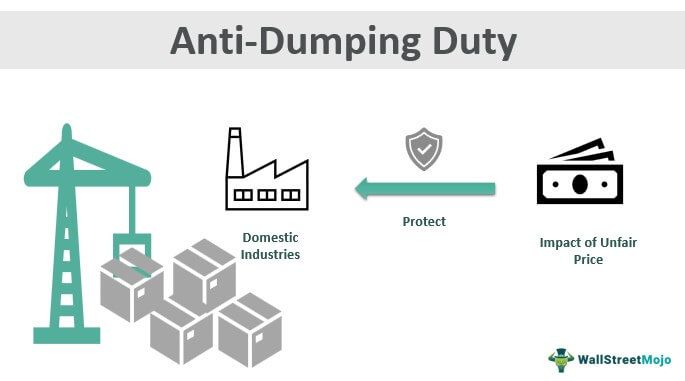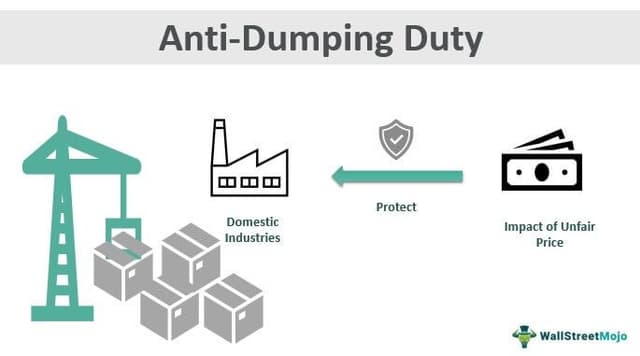Table Of Contents
What Is Anti-Dumping Duty?
Anti-dumping duty is the amount of tax or duty that is imposed on the import of products or services when the imports are priced by foreign sellers lower than the price that those products or services will fetch in the open market of the domestic country of those foreign sellers.

Anti-dumping Duty intends to protect domestic industries from the impact of unfair price reductions by foreign exporters. Therefore, it must be imposed with the utmost care and only when it causes some threat to domestic industries.
Key Takeaways
- Anti-dumping duty is a tax or duty imposed on imported products or services when their prices are lower than the fair market value in the domestic country.
- The purpose of anti-dumping duty is to level the playing field and protect domestic industries from unfair competition caused by dumped goods.
- Two values are used to determine anti-dumping duty: the normal value, which represents the fair market value in the exporter country, and the export value, which is the actual price at which the product is exported.
Anti-Dumping Duty Explained
- When foreign exporters export their goods to another country at a price less than the prevailing price in their local markets, there is a risk to the importers' manufacturing companies operating in the domestic region.
- To protest the interest of the domestic business houses, the land government imposes a reasonable amount of duty on such imports, keeping in mind the amount by which the foreign exporters are reducing prices.
- After the imposed anti-dumping duty rates, the import and domestic product prices came to equilibrium. The domestic business houses and foreign exporters come at par in terms of competition. A government imposes the responsibility only when domestic industries cause some serious threat.
However, the anti-dumping duty formula will help to understand the concept.
How To Calculate?
Let us understand the anti-dumping duty calculation.
We have understood by now that the basis for imposing the anti-dumping duty is the difference in prices of a product at which it is exported compared to the cost of such development in the open market of the exporter country (i.e., the fair price of such a product).
Thus, , anti-dumping duty formula is as follows.
Now, let us understand what does “Normal Value” and “Export Value” mean.
#1 - Normal Value
- The normal value means the domestic fair value of such or any similar product in exporter country.
- If the normal value can't be evaluated in the absence of domestic sales by the exporter in his country, then there are two other ways by which we can calculate the Normal value.
- The price at which such a product or any similar product is exported to another country may be considered.
- If such price is also not available then the cost of production is increased by overhead expenses and a reasonable profit margin may be considered to be normal value.
#2 - Export Value
- As the term suggests, it is the value at which a product is exported. It means the FOB (Free on Board) price of the product. The value of dumping can be calculated when the product's normal matter in the exporter's country is compared against the FOB price of the product (and not CIF price, since Cost, Insurance and Freight price will include the effect of freight and insurance too).
- Having talked about calculating Anti-Dumping duty, let us look at a few example of anti-dumping duty.
Examples
Below are the examples of anti-dumping duty calculation.
Example #1
Suppose Mr. John of the USA exports machinery to Mr. Ram of India. He sells the machine to Mr. Ram for $ 40,000 on the FOB contract. However, Mr. John sells machinery of the same kind in the local markets of the USA for $44,000. Then, anti-dumping duty is calculated as below:
Solution:
Calculation of Anti-Dumping Duty can be done as follows:

- Anti-Dumping Duty = $44,000 - $40,000 = $4,000
Example #2
Now, assume if, in the case of the first example, the machinery of the same kind is not being sold by Mr. John in the USA, and the same was made on the custom request of Mr. Ram. However, a machine with similar features and functions was exported by Mr. John to Mr. Gayle of South Africa for $ 50,000 on CIF Basis. The expenses incurred on freight and insurance on the machinery was $ 1,000. Now, let us see how the anti-dumping duty will be calculated.
Solution:
Calculation of Normal Value can be done as follows:

- Normal Value = Export price of a product in 3rd Country - Freight and insurance expenses
- Normal Value = $ 50,000 (CIF Value) - $ 1,000
- Normal Value = $ 49,000 (FOB Value)
Calculation of Anti-Dumping duty can be done as follows:

- Anti-Dumping Duty = $49,000 - $40,000 = $9,000
Example #3
Again, moving with the same example, let us assume that no such machinery was sold to anyone other than Mr. Ram. However, we have the following data about the production of machinery.
- Cost of production of machinery = $32,000
- Allocation of overhead costs to machinery = $ 4,000
- Mr. John earns an average profit of 20% on all his productions.
Solution:
Now,

- Normal Value = $ 32,000 + $4,000 + 20% of ($32,000 +$4,000)
- Normal Value = $43,200
Calculation of Anti-dumping duty can be done as follows:

- Anti-Dumping Duty = $43,200 - $40,000 = $3,200
Thus, the above example of anti-dumping duty makes the concept clear.
Benefits
- Imposing anti-dumping duty protests the country's domestic businesses against the unfair competition created by foreign exporters by reducing the export prices against their fair price.
- Such exporters for dumping intend to establish market shares in other countries by offering lower prices. As a result, the market share of domestic business houses gets affected. Thus, anti-dumping duty acts as a weapon to curb such unfair pricing policies, and competition becomes fair.
Limitations
- As everything has pros and cons, anti-dumping duty rates also have their share of cons. For example, while anti-dumping duty protests the interest of domestic industries, it creates a barrier to free trade between economies.
- As a result, the economy of such a country that imposes a duty suffers the consequences of restrictive entry into its market. Moreover, it is against the interest of domestic consumers as they are restrained from obtaining the products at lower prices.
Anti-Dumping Duties Vs Countervailing Duties
Apart from anti-dumping duty, sometimes countervailing duty is also imposed by governments. It is imposed to nullify the effect of subsidies available to exporters in their countries.

